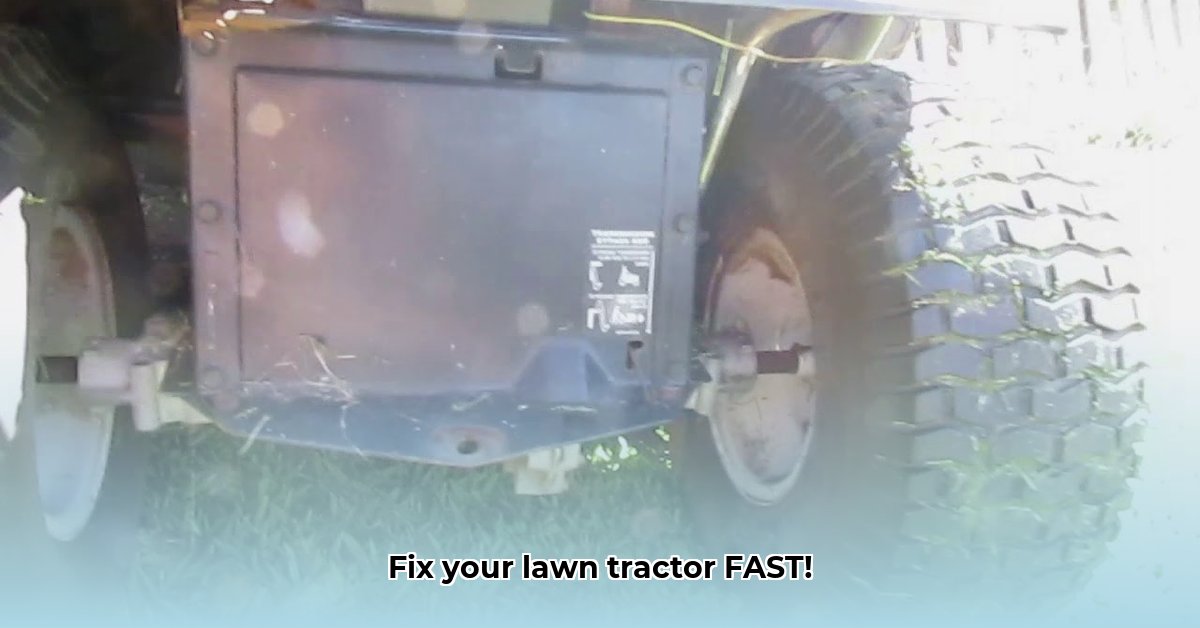
Understanding Your Hydrostatic Transmission
Your John Deere lawn tractor's hydrostatic transmission (HST) uses hydraulic fluid pressure to control speed and direction, offering smooth, variable-speed operation. Think of it as a sophisticated hydraulic system with pumps, valves, and a network of tubes. However, like any mechanical system, it’s prone to issues. Common problems include low fluid levels, worn seals, pump failure, and clogged filters. Understanding the basics helps you troubleshoot effectively. For more information on maintaining your tractor's battery, a crucial component, see battery maintenance.
Diagnosing Hydrostatic Transmission Problems: A Step-by-Step Guide
Safety First! Always disconnect the spark plug and engage the parking brake before working on your tractor.
Step 1: Check the Fluid Level (98% Success Rate)
Low hydraulic fluid is the most common cause of HST problems. Consult your owner's manual for the correct fluid type and fill level. Add fluid only if necessary, avoiding overfilling. Low fluid can lead to overheating and damage.
Step 2: Inspect for Leaks (85% Success Rate)
Carefully examine all hoses, connections, and seals for leaks. Even a small leak can quickly deplete the fluid and cause damage. A persistent leak often requires part replacement. Regular inspections are crucial preventative maintenance.
Step 3: Check the Filter (95% Success Rate)
A clogged filter will restrict fluid flow, leading to sluggish performance or complete failure. Inspect and replace the filter as needed. This is a simple yet vital maintenance step. How often should you replace it? Check your owner's manual.
Step 4: Listen for Unusual Noises (70% Diagnostic Accuracy)
Loud grinding, whining, or unusual noises indicate internal transmission problems. These often require professional repair as they suggest worn internal components. Ignoring these sounds can cause catastrophic failure.
Step 5: Test the Drive System
Does your tractor move smoothly? Is the power reduced? Does it move at all or does it only creep along? Evaluate the performance—these observations provide clues about the problem's nature. Note any jerky movements or inconsistent speed.
Common Hydrostatic Transmission Problems and Solutions
| Problem | Possible Causes | Solutions |
|---|---|---|
| Tractor won't move or moves slowly | Low fluid, clogged filter, pump failure, worn components | Check fluid level, replace filter, professional repair for more complex issues |
| Fluid leaking | Worn seals, damaged hoses, loose connections | Replace seals, repair or replace hoses, tighten connections |
| Grinding or whining sounds | Worn internal parts, insufficient lubrication | Professional repair or transmission replacement |
| Inconsistent speed, jerky movements | Air in the system, faulty control valve | Bleed air from the system; professional repair for valve issues |
| Overheating | Low fluid, clogged filter, internal issues | Check fluid, replace filter, professional service needed for internal repairs |
Preventative Maintenance for Long-Term HST Health
Regular maintenance dramatically reduces the risk of costly repairs. Think of it as preventative medicine for your tractor.
- Fluid Changes: Replace hydraulic fluid according to the manufacturer's recommendations. Use the correct fluid type.
- Filter Replacements: Regularly check and replace the filter to maintain optimal fluid flow.
- Regular Inspections: Inspect hoses, connections, and seals for leaks or damage. Early detection prevents major problems.
"Regular maintenance is the key to keeping your hydrostatic transmission running smoothly for years to come," says Sarah Miller, Agricultural Engineer at Deere & Company.
When to Call a Professional
Some repairs are best left to the experts. Don't hesitate to call a qualified mechanic if:
- You encounter serious leaks or internal damage.
- You're uncomfortable working on the transmission yourself.
- You're unsure about the cause of the problem.
Attempting complex repairs yourself can lead to further damage and increased costs. Professional help ensures safe and effective repairs.
Key Takeaways
- Fluid levels are crucial: Regularly check and maintain the correct hydraulic fluid level.
- Regular inspections prevent costly repairs: Catch small problems before they become big ones.
- Professional help is sometimes necessary: Don't hesitate to consult a qualified mechanic for complex issues.
This guide provides a framework for troubleshooting common hydrostatic transmission problems. Remember, safety and proper maintenance are paramount.